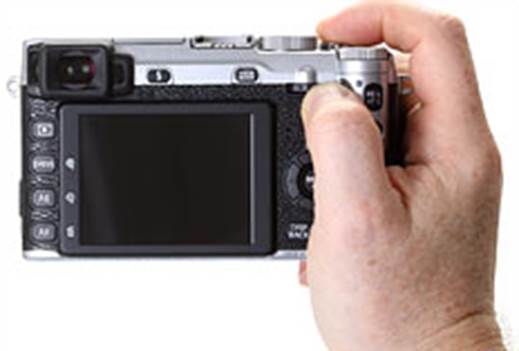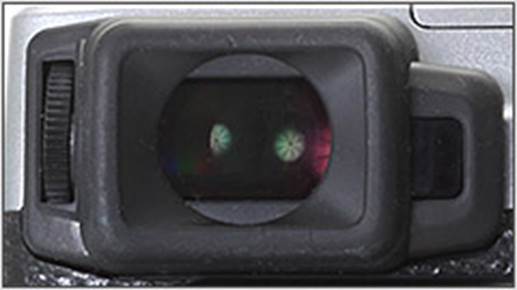Using the X-E1
The X-E1’s body is a little smaller and
shorter and lighter than the leading X-Pro1, which is a good change for
photography enthusiasts. Not only the body, but also main exposure controls
also have the really classic design, with a manual shutter speed dial and, in
the case of 18-55mm zoom lens, a mechanical –style aperture ring. A switching
button manually defines the lens that is activated to adjust the aperture or
set to the Auto. If it is installed the Auto, aperture is set automatically,
and the ring is disabled.

The
X-E1’s body is smaller and shorter
There is no truly mechanical connection
between the ring and the aperture, and you can rotate the ring through
360-degrees without hard stops at minimum or maximum aperture, but when the
function of the ring is set to aperture, a movable bolt of the ring changes the
aperture around 1/3V. In contrast, the X-mount fixed-lens has a special ring
with markings and 1/3-stop accelerator, with a setting for Auto aperture is
marked with the red "A" letter.
The physical design of the X-E1 is not only
too convenient, and besides the narrow entrance on the front for your fingers,
the X-E1 feels unapologetically mechanical, which is part of its
fascination. Regardless of the lens mount, the X-E1 keeps its good balance, and
the machine body itself is surprisingly mild. The body only feels less
significant than the X-Pro1, but with a lens mount, its weight is just right
for the size. Only the 18-55mm lens zooms, which have nearly the same weight as
the camera makes us feel its presence.
In
your hands

The
X-E1 is smaller than the X-Pro1, but its handle and outstanding thumb hook
provide a fairly certain hold, even with just one hand. The aperture ring on
the lens nonetheless encourages by the two – hands holding, even when using a
fixed lens.
One of the main weaknesses of the HG-XE1
handles (shown in the picture above) is that you have to remove it to change
the battery and memory card; it actually provides the Leica M9 experience but
is not in the good way. It also tends to pull the camera forward onto the lens
when put on a flat surface, and when holding the camera with the attached
handle, your hand is forcedly placed to the right, which is likely to be quite
annoying at first but feels normal for a later time.

While
we had no problem with the purchase of a rectangular body and small handle of
the X-E1, when we held the camera and HG-XE1 handles around the office,
everyone agreed that it had an improvement.
Electronic
viewfinder
The electronic viewfinder of the X-E1 is
the key of its activities, and the 2.36M dot OLED panel looks like the same
unit used in the NEX-7 and NEX-6 by Sony (and a few of its SLT cameras), and so
it is pretty good in terms of the art. But the panel itself is quite far from
the whole story, and Fujifilm is also being supposed to use the optics in the
eyepieces. Two glass lenses, including a dual-sided a spherical lens that give
an impressively clear vision in the corners of the frame and a corresponding
long eye point of 23mm that makes the finder comfortable for the users wearing
glasses.
The magnified optics is lower than those
used by Sony, and provide a viewfinder image approximately the same sizes as
from X-Pro1’s (and therefore a bit larger than the E-M5). The picture directly
previewed of Fujifilm also has lower contrast than Sony’s, which means the
viewfinder of the X-E1 tends to block up the shadows in bright conditions, with
the expense of a few impacts immediately in the general viewing experience.
This does not have any impacts on the final image, but causing constitution to
be easier in contrast scenes.
When you put the viewfinder in front of
your eye, the infrared sensor discovers this and switches to the viewfinder
mode. The moving speed is fast enough to create a stable user experience, but
we found that with the hot sun behind your back, the eye sensor does not always
know when you're keeping your eye in front of the viewfinder, and might operate
erratically.

The
X-E1’s EVF uses a 2.36M – dot OLED panel. On the right of the eyepiece is a
proximity sensor that helps the camera to switch automatically between the LCD
and EVF; or you can use the "View Mode" button to move by hand; On
the left is a gear to adjust the diopter.
Detail resolution is very high, as we
expected from the technical specifications, like all EVFs, though the diagonal
lines at a horizontal/ vertical hollow angle to display a few
"terraces". The X-E1’s EVF also turns out to be slightly laggy in
low light, a little more than what we've seen from the Sony NEX-6, but we would
not call it a problem unless you are trying to chase reasonably fast moving.
Interestingly, the directly viewing image of the X-E1 freezes and pixelates for
a fraction around less than a second when requiring AF, which can be dispersed,
and gives the impression of a low resolution experience when creating a
photograph.
Setting
the exposure mode and shooting parameters
Setting both of the lens and shutter speed
to Auto is equivalent to choosing the Program mode. Aperture and Shutter
priorities are set by setting lens or rotating shutter to Auto, creating a
manual selection with one or the other; and manual mode is obviously
equivalent: setting both is manually controlled. It is impossible to be easier
and much more familiar for those who are used to working with the cameras
similarly designed in the last century. While it may seem strange to some
people, it is quite logical to have the controls for the lens on the lens, while
the shutter controls are located on the camera body. Photography students
seemed that they would probably benefit from this distinction.
In the Program mode, you can transfer the
exposure parameters selected by the camera towards a faster shutter speed /
larger aperture or smaller aperture / slower speed by pressing the Left/ Right
buttons; transferred values are expressed on screen in yellow. Program transfer
is not available if we set up to Auto ISO or Auto DR.
The Fujifilm X-E1 does not have an ISO dial
or even a dedicated ISO button. However, you are able to assign ISO to the
programed Fn button beside the shutter for one-touch access, or access it from
the Quick Menu. We'd expect to have the option of changing it directly using
the rear dial, which does not work in normal shooting.